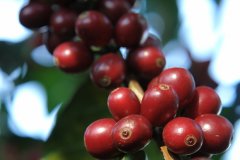Panamanian Coffee Indian Culture Mature Cherry Panamanian Coffee Unique Flavor
Since early times, Panama's coffee industry has relied on the skilled hands of Ng ö be-Bugl é Ngabe-Burger Panamanian Native Indians, who have for decades migrated from their home "comarca Hill" to work on the Baru Volcano Coffee Farm.
Ng ö be-Bugl é Ngabe and Burger are actually two different languages / the languages of indigenous groups are not interlinked. The larger Ngabe speaks Ngabe, while the smaller ethnic group, Burger, speaks Bugle; both are members of the Chibucha family. Overall, these two groups account for the largest indigenous population in Panama. Ng ö be-Bugl é Ngabe and Burger live in the reserve, located northeast of Chiriki in the mountains, which is part of the Taramanca Mountains.
Ng ö be-Bugl é Ngabe and Burger Panamanian Indians are valuable workers in coffee production: what we have learned from them allows ripe cherries to choose the right technology. With the selection of cherries, Panamanian Indian aborigines pick them by hand to ensure coffee quality control, which makes Panamanian coffee unique.
Coffee farms in Panama respect the culture and way of life of indigenous Indians and strive to improve their conditions. Some members of the SCAP Panamanian boutique coffee association have comprehensive social programs for health, nutrition, education and proper care of children to provide a better quality of life for them and their families.

Important Notice :
前街咖啡 FrontStreet Coffee has moved to new addredd:
FrontStreet Coffee Address: 315,Donghua East Road,GuangZhou
Tel:020 38364473
- Prev

Introduction of Sidamo coffee beans with clear acidity and smooth taste
Unlike ordinary African coffee, Sidamo has clear acidity, smooth taste and delicate floral smell. Washing Sidamo is elegant and playful. The entrance is mild and pleasant, with a strong taste impact with the bright lemon acid later on. The palate is unique and mellow, with a chic and pleasant aftertaste. The slowly rising finish contains chic sweetness. Coffee and raw beans are grayish
- Next

Rose geisha Arabica variety geisha coffee coffee cherry bright honey and citrus flavor
Boutique coffee (specialty coffee) is also called specialty coffee selection coffee. It refers to coffee made from a small number of raw beans with excellent taste grown in an ideal geographical environment. Depending on the special soil and climatic conditions in which they grow, they have outstanding flavor. After strict selection and classification, this kind of coffee is hard in texture, rich in taste and stylish.
Related
- Does Rose Summer choose Blue, Green or Red? Detailed explanation of Rose Summer Coffee plots and Classification in Panamanian Jade Manor
- What is the difference between the origin, producing area, processing plant, cooperative and manor of coffee beans?
- How fine does the espresso powder fit? how to grind the espresso?
- Sca coffee roasting degree color card coffee roasting degree 8 roasting color values what do you mean?
- The practice of lattes: how to make lattes at home
- Introduction to Indonesian Fine Coffee beans-- Java Coffee producing area of Indonesian Arabica Coffee
- How much will the flavor of light and medium roasted rose summer be expressed? What baking level is rose summer suitable for?
- Introduction to the characteristics of washing, sun-drying or wet-planing coffee commonly used in Mantenin, Indonesia
- Price characteristics of Arabica Coffee Bean Starbucks introduction to Manning Coffee Bean Taste producing area Variety Manor
- What is the authentic Yega flavor? What are the flavor characteristics of the really excellent Yejasuffi coffee beans?

